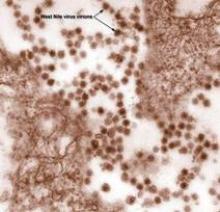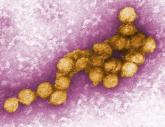A total of 87 people have now died from West Nile disease – an additional 22 fatalities since the last national update on Aug. 28.
The overall number of infections also continues to increase, with 403 new cases reported as of Sept. 4. The total case count now stands at 1,993, Dr. Lyle Petersen reported during a Centers for Disease Control and Prevention press briefing.
Of these, 1,069 (54%) have been classified as neuroinvasive disease and 924 (46%) as nonneuroinvasive disease said Dr. Petersen, director of CDC’s Division of Vector-Borne Infectious Disease.
Only two states – Alaska and Hawaii – have not reported the virus, Dr. Petersen said. Every other state has reported infections in mosquitoes, birds, or people.
"The cases reported thus far in 2012 are the highest number of West Nile virus disease cases ever reported to CDC through the first week in September, since the disease was first detected in the U.S. since 1999," he said. More than 70% of the cases are in six states (Texas, South Dakota, Mississippi, Oklahoma, Louisiana, and Michigan), with nearly half in Texas alone.
The disease continues to ravage that state, according to Dr. David Lakey, commissioner of the Texas Department of State Health Services. Since Aug. 28, Texas has reported an additional 230 cases, bringing that state’s total to 1,013. There also were 69 more cases of neuroinvasive disease, for a total of 485.
Nine more people died in Texas, he added during the briefing. The total death count in Texas now stands at 40. It’s the worst outbreak of West Nile since 2003, when 40 people died from the disease during the entire event.
"When we look at data, a quarter of the deaths were reported in last week alone. Unfortunately that count will continue to go up. There will be more cases of neuroinvasive disease and more deaths."
Some relief may be in sight, he said. "There are some indicators that the disease in the northern part of the state may have peaked."
Aerial spraying in some areas decreased the numbers of mosquitoes significantly Dr. Lakey said. In northern Texas, recent mosquito pool sampling showed that just 6% of the insects carried the virus – a significant decrease from the 93% infection rate in the last pool samplings.
"In other parts of the state, however, a large number of pools are still infected," he said, including a 28% rate in the area of Austin and Travis County.



